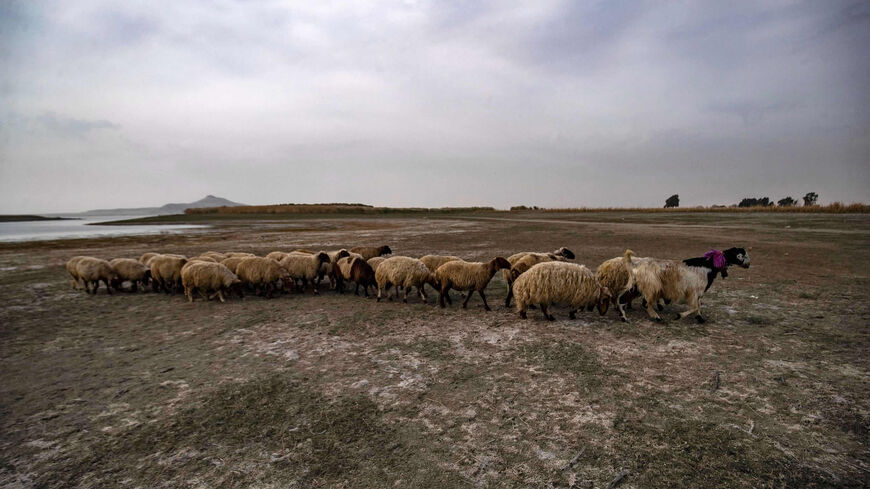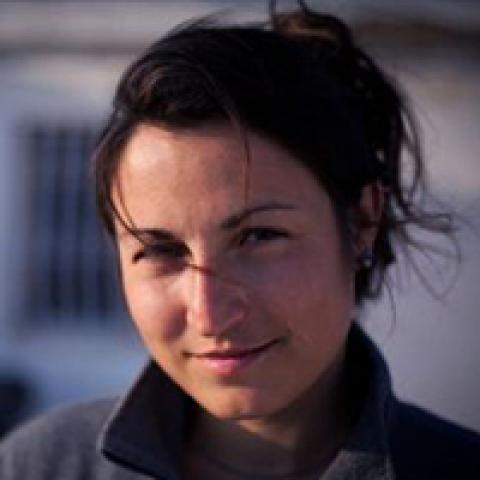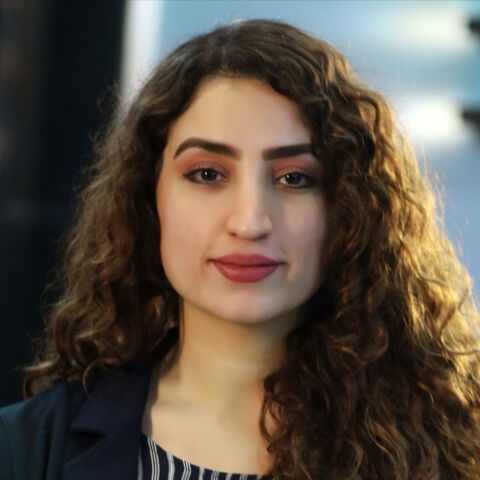QAMISHLI, Syria — The double earthquake that shattered thousands of lives across northwestern Syria this month was not the first natural disaster to strike the country this year.
In the northeast, relatively spared by the two earthquakes, farmers have been reeling from a historically severe drought that has seen wheat production plummet to a fourth of its pre-war level.
In the summer of 2020, after a good harvest fueled by abundant rains, Syria became enmeshed in its worst drought of the past 70 years. Rains failed in the winter of 2020, and from October 2021 to May 2022 reached levels 75% to 95% lower than historical averages in the country’s northeastern provinces of Hasakah, Raqqa and Deir ez-Zor, considered the breadbasket of Syria.
Against all hopes, rains failed again at the end of 2022, and Syrians now face the daunting prospect of a third year without water. At the beginning of February — which is considered very late — heavy rain and snow finally doused the area and almost overnight, scorched stretches of brown land blossomed with the green tinge of crispy grass. But the harvest is nowhere near saved: it is almost spring and regular rain episodes will be needed until the end of winter to sustain the crops.
Vulnerable to the whim of increasingly unpredictable weather, northeast Syria’s farmers are losing hope year after year with no solution in sight. Torn between reckless well-drilling, faith in new technology and the revival of old traditions, farmers’ scramble for solutions reflects huge gaps in their abilities to adapt to a changing climate.
A natural disaster
An overwhelming majority of people in northeast Syria depend on agriculture for a living, and drought has taken a heavy toll. According to a recent humanitarian assessment by Mercy Corps, agricultural production decreased by more than 80% in 2022 compared to 2020, the last harvest before the onset of the current drought.
Wheat, a diet staple in Syria and a key component of dozens of local value chains — from bread, freekeh and bulgur production to the pastry and sweets industry — was among the most affected crops because most cereal fields in Syria are located on non-irrigated land. But other essential sectors have also suffered.
The head of a union of livestock owners, representing 80 cattle farmers in Hasakah province, talked to Al-Monitor about the challenges herders are facing. “Our sheep have nothing to graze on. Herders can’t afford to keep their cattle, so they are selling half of the flock to feed the rest,” he told Al-Monitor on condition of anonymity.
In hard times, herders would normally compensate for the lack of pasture with fodder. But hay and barley — a rain-fed crop traditionally used for animal feed — are hard to come by this year after two failed harvests.
#Syria: Farmers in Idlib say the wheat harvest is low again this year because of drought, high irrigation costs & shrinking arable land.
— Mark Cutts (@MarkCutts) June 14, 2022
This, combined with the global rise in food prices as a result of the war in #Ukraine, is leading to a growing crisis of food insecurity pic.twitter.com/bv2gSXlX5Z
As farmers struggle to cope with the crisis, northeast Syria has witnessed the revival of old rituals meant to attract rain — like “rain bride” parades, a celebration traditionally performed in rural areas to break a dry spell.
At the end of January, several weeks without rain prompted one neighborhood to organize a rain bride ceremony in the city of Qamishli. Walking behind a teenage girl holding a pink fabric doll on a wooden stick, a procession of children poured through the streets of their neighborhood, following the “rain bride” through the densely knitted labyrinth of mud-brick houses and courtyards. The ceremony concluded with a feast for the children, who dipped their fingers in piles of bulgur and fuming dishes prepared by the neighbors.
For local residents, who don’t directly depend on agriculture for a living, the parade marked an attempt to obtain economic blessings through a public act of charity. “Feeding the children of the neighborhood is an act of goodness that we hope will be rewarded by God,” one of the women who organized the parade told Al-Monitor. “Previous generations used to do these offerings, and we decided to renew this tradition this year because the rain is very late.”
The family who sponsored the event spent around 1 million Syrian pounds (around $135) on the feast, roughly three times the salary of a public sector employee. But rain is a priceless blessing. “What is good for the land is good for all of us,” the woman, who preferred to remain anonymous, said.
The shadow of climate change
Recurrent droughts have long plagued northeast Syria, a semi-arid region lying on the fringes of the desert. But three years is unusually persistent by all accounts, and some experts fear the usual cycles of episodic droughts broken by abundant rains may not return.
Joseph Chalhoub, coordinator of the Food Security and Livelihoods working group of the NES Forum, a humanitarian platform coordinating nongovernmental organizations (NGOs) in northeast Syria, told Al-Monitor that Syria will have to adapt to the droughts. “This year will be pivotal for Syria. The past two years were seen as exceptions, but a third consecutive year will mark the beginning of a trend. This could greatly change the way local authorities, NGOs and farmers themselves perceive this drought.”
The Middle East region is likely to experience increasing temperatures, decreasing rainfall and accelerated desertification in the coming years due to climate change, whose shadow looms over northeast Syria’s arid environment and depleting water resources. Already, farmers feel its effects and report experiencing higher temperatures, more erratic rains and more frequent dry spells. But they seldom label these issues as “climate change,” a phenomenon that remains misunderstood.
A wheat farmer in the countryside of al-Qahtaniyah who requested anonymity told Al-Monitor that he does not understand the concept of climate change. “We hear about this thing called climate change but to be honest, I don’t understand what it is. I’ve heard it is caused by pollution from the nearby oil refineries,” he said.
Like him, many farmers see the drought as a temporary natural episode and blame their woes on other — and equally important — structural issues: the destruction of irrigation infrastructure during the war, the decline of institutions that used to support them and manage rangelands, or the skyrocketing price of fuel and imported agricultural inputs.
Coping with drought
In Syria’s recent history, beating drought relied on a simple strategy: pumping more water from underground. Irrigated surfaces expanded by 127% and the number of licensed boreholes jumped from 53,000 to 124,000 in the first half of the 1990s alone.
But this strategy has already shown its limits. Most agricultural boreholes in the north of Hasakah province are surface wells that recharge through rainwater and are quickly drying out, or farmers can’t afford the fuel required to pump water out. As for deep boreholes, which tap into slowly recharging aquifers, they are also over pumped, which led local authorities in northeast Syria to ban the drilling of new agricultural wells last fall.
Just arrived in #Syria. After 12 years of conflict, drought and economic devastation, I’m here to remind the world about what’s happening in this nation. The world cannot turn its back on the Syrian people in this hour of unprecedented hunger. pic.twitter.com/ENGb2de5tK
— David Beasley (@WFPChief) January 26, 2023
Faced with persisting drought and dwindling water resources, authorities and the aid sector are pushing farmers to adapt through “water-wise” solutions and “smart” irrigation systems, instead of flooding their land periodically — a traditional form of irrigation. But few can afford the switch.
“We couldn’t buy a whole system to water our fields with sprinklers, but we were able to rent one pipe and 20 sprinklers,” the wheat farmer on the outskirts of al-Qahtaniyah said, pointing toward his half-watered fields. To save money, he moves this single line around from one section of the field to another every few hours, watering the land in sections.
For many others, adaptation to a future with less rainfall seems largely out of their lands. Irrigating the baal — the local name given to nonirrigated lands that are rain-fed, which represent an estimated 70% of farmland in northeast Syria — would require huge investments in water infrastructure: deep boreholes, pumping stations and canals, and tapping into dwindling groundwater resources. For farmers in the baal and livestock herders, life depends on rain, and they will continue to plead with fate and with God for a generous season.








